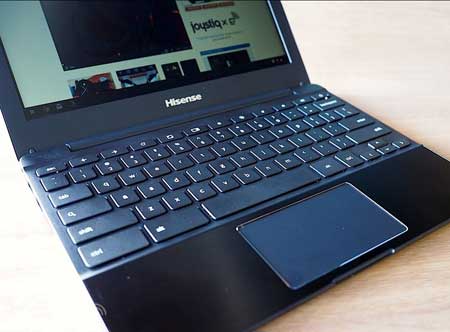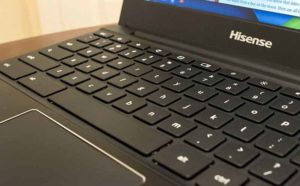Review: Budget-priced Hisense Chromebook packs a lot of value in small package

The Hisense Chromebook is one of the lowest-priced Chromebook models available. The Hisense packs a lot of value in a small and lightweight package.
By JIM BROOKS
Nelson County Gazette / WBRT Radio
Saturday, Sept. 17, 2016, 5 p.m. — Whenever I’m discussing computers with my 20-year-old son, I frequently am reminded of just how much technology has changed since I got my first personal computer — a Commodore C-64 in 1984.
The decision to buy a computer usually means balancing what one needs versus what one can afford. In education circles, that’s an important balancing act that has prompted the rise of a new type of computer — the Chromebook.
Chromebooks are low-cost laptop computers based on the Linux operating system and operate using the Google Chrome web browser. Since their debut five years ago, Chromebooks have taken the education market by storm — and for good reason.
For starters, they are much cheaper than traditional laptops running Windows or Mac operating systems. They are designed with ease-of-use,  portability and long battery life in mind.
portability and long battery life in mind.
You may ask yourself, “Self, isn’t this just a crippled laptop that’s useless for most non-educational applications?”
The short answer is “Nope, not at all!” In fact, I have been able to do everything I need to do to manage the Nelson County Gazette using the Hisense Chromebook — and that includes editing text and photos, and then managing the site through its WordPress interface.
If I sound a little surprised, I am. I bought this Chromebook fully expecting to run into its limitations at every turn. While it has its limits, it has turned out to be an amazingly versatile machine.
THE HISENSE CHROMEBOOK. With a retail price of $149.99, the Hisense C-11 is one of the least expensive Chromebooks on the market. It features an 11.6-inch HD LCD screen. For its size, the screen is considerably better than the screens on earlier netbooks like the 8.9-inch display on the Acer Aspire One marketed six or seven years ago.
The Hisense is powered by a quad-core processor and equipped with 2GB of RAM and a 16GB solid state hard drive. That’s not a lot of storage space; however, because a Google account is required to operate the Chromebook, each Google account includes up to 15 GB of shared storage space (shared between Google apps and services). And the beauty of using Google storage is that your work is available at any computer you use when you log back into your Google account.
WHAT THE CHROMEBOOK IS NOT. One thing to remember is that Chromebooks are designed to operate applications via the Chrome web browser — and that will require an internet connection. If you frequently depend on non browser-based applications for your business or personal work — including just about every PC-based videogame and certain business software — you’re pretty much out of luck.
Of course, you can often find browser-based replacements that can get the job done. Admittedly, Sumo Paint does a pretty good job of basic photo editing, but there’s no browser-based software available to replace my PC-based video editing software.
Those caveats aside, the Chromebook remains a great value that will most likely handle all or nearly all of your daily personal computing chores. It’s fast and at 3.3 pounds, very light and easy to handle.
The portability of the Chromebook may sound like a no-brainer, but I have suffered the impact of making poor portability choices in the past.
A couple of years ago I bought a new laptop that featured a 17.3-inch display. Its a great laptop, but this 7-pound-plus behemoth is like packing a 4×8 sheet of plywood under your arm; portability is NOT its strong suit.
I later picked up a late model HP 15.6-inch laptop that was certainly smaller, but still weighed in at 5-1/2 pounds — lighter yes, but still something of a moose to pack around.
Enter the Hisense Chromebook, which weighs 2 pounds less than the HP in a more compact and thinner package. And it goes without saying that if you lose the Hisense, drop it or dump your coffee on it, replacing it is significantly less expensive than the cost to replace your average Windows or Mac-based laptop.
There are a wide range of Chromebook models offered by most major laptop manufacturers, and you can spend well over $300 for one of the higher-end Chromebook models if that’s your choice. The Hisense is one of the lowest priced Chromebooks; higher-priced models feature more storage, more accessory ports, etc. Compare features and chose the model that will best fit your needs.
I’ve turned my nose up at the Chromebook concept for years, but after giving one a test drive, I’m a believer. Chromebooks represent the best opportunity to get computers in the hands of school-aged children. Don’t overlook the budget-priced Chromebook as an option that can fill a need for inexpensive, fast and portable computing in your home or office.
-30-






